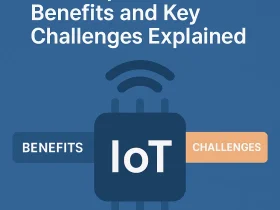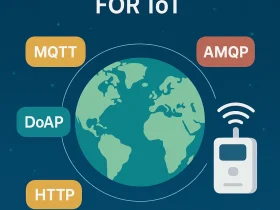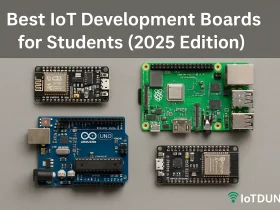Full guide to Sensors meaning, Types of Sensors, Smart Sensors, and Wireless Sensors (2025)
What is a Sensor?
A sensor is an electronic device that measures a physical quantity (like temperature, motion, light, or pressure) and converts it into a signal that can be read and processed electronically. In simple terms, a sensor detects changes in its environment and responds with a signal, usually electrical, to enable a system to react.
Sensors are pivotal to modern electronics, enabling the automation and intelligence embedded in everything from smart homes to industrial machinery.
Role of Sensors in the IoT Age
With the expansion of the Internet of Things (IoT), sensors are now essential in capturing the physical world’s data and turning it into actionable insights. The number of IoT-connected devices is expected to exceed 25 billion by 2025, with sensors embedded into each of them — forming the “nervous system” of this connected world.
From real-time temperature tracking in smart fridges to detecting air quality in cities, sensors enable:
- Environmental monitoring
- Industrial automation
- Smart energy usage
- Personalized healthcare
- Smart mobility and logistics
Types of Sensors traditional

1. Temperature Sensors
These sensors convert temperature variations into analog or digital signals.
Types include:
- Thermocouples
- Thermistors
- Resistor Temperature Detectors (RTDs)
- Infrared (IR) Sensors
- Semiconductor-based IC Sensors
Applications: HVAC, manufacturing, medical devices, wearables, and industrial climate control.
2. Proximity Sensors
Used to detect nearby objects without any physical contact.
Subtypes:
- Capacitive
- Inductive
- Photoelectric
Applications: Retail displays, smartphones, reverse parking systems, airports, and robotics.
3. PIR (Passive Infrared) Sensors
Detect motion by sensing infrared radiation.
Applications: Security alarms, automatic lighting systems, and motion-detecting cameras.
4. Ultrasonic Sensors
Use ultrasonic sound waves to detect object distance or level.
Applications: Car reverse assist, water level detection, and blind zone detection.
5. Speed Sensors
Measure the speed of moving objects like vehicles or conveyor belts.
Types: LIDAR, Doppler radar, Speedometers, Ground speed radar
6. Pressure Sensors
Detect pressure changes and convert them into electrical signals.
Applications: Water systems, HVAC systems, industrial automation, and automotive applications.
7. Chemical Sensors
Detect chemical changes in gases or liquids.
Types: pH sensors, gas sensors, electrochemical detectors, FET-based sensors
Applications: Air quality monitoring, toxic gas detection, pharmaceutical labs, and space research.
8. Water Quality Sensors
Detect water parameters including:
- Turbidity
- Chlorine
- pH
- TOC (Total Organic Carbon)
- Conductivity
- ORP (Oxidation-Reduction Potential)
Applications: Wastewater plants, environmental monitoring, industrial water usage.
9. Gyroscope Sensors
Measure orientation and angular velocity.
Types: MEMS, Optical, Rotary, Vibrating Structure
Applications: Aerospace, smartphones, VR devices, drones, wearable fitness trackers.
10. Optical Sensors
Convert light into electronic signals.
Components:
- Fiber optics
- Photodetectors
- Pyrometers
Applications: Medical diagnostics, high-speed communication, elevators, smart lighting.
Smart Sensors: Intelligence at the Edge

What Are Smart Sensors?
Smart Sensors are next-generation sensors integrated with:
- Signal conditioning
- Embedded microprocessors
- Communication capabilities
- Local data processing
They sense, analyze, and communicate data — minimizing the need for centralized processing.
Smart Sensor Information Architecture
A typical smart sensor system includes:
1. Primary Sensor
- The actual sensing element (e.g., thermistor, accelerometer) that detects physical changes.
2. Signal Conditioning Unit
- Amplifies, filters, and converts analog signals into digital form.
3. Microcontroller/Processor (MCU)
- Performs calibration, digital filtering, error correction, decision-making, and communication formatting.
4. Transceiver / Communication Interface
- Sends processed data via Wi-Fi, Bluetooth, Zigbee, LoRa, or NB-IoT.
5. Power Supply
- Battery-operated or energy-harvesting (solar, vibration, RF)
6. Data Memory/Storage
- Stores sensed values locally until transmitted
Advanced Capabilities of Smart Sensors
- Edge Computing: Processes data near the source to reduce latency
- Self-Diagnostics: Monitors own performance
- Self-Calibration: Adjusts baseline to reduce drift
- Energy Efficiency: Sleeps and wakes based on events
- Multi-sensing: Measures multiple physical properties simultaneously
Smart Sensor Use Cases

1. Temperature Smart Sensors
- Thermostats, weather stations, cold chain logistics
2. Air Quality Smart Sensors
- Detect CO₂, VOCs, and trigger air purifiers
3. Motion Smart Sensors
- Security, automation, occupancy detection
4. Light Sensors
- Trigger camera night vision, adjust screen brightness
5. Smog & CO Detectors
- Detect pollutants, send alerts, inform fire departments
6. Plant Sensors
- Soil moisture, fertility, and light conditions for agriculture
7. Smart Climate Sensors
- Measure humidity, pressure, temperature, weather forecasting, smart irrigation
Wireless Sensor Technology

What is a Wireless Sensor?
A wireless sensor detects physical conditions (like temperature or pressure) and transmits the data wirelessly — without any physical connection to a controller or data logger.
They are central components in Wireless Sensor Networks (WSNs) which enable scalable, flexible, and real-time monitoring across vast areas.
Wireless Sensor System Architecture
1. Sensor Node (End Device)
- Contains the sensing unit + microcontroller + transceiver + power supply
- Gathers and transmits data to the gateway
2. Gateway/Hub
- Collects data from multiple sensors
- Converts sensor protocols (Zigbee, LoRa) into IP-based formats
- Sends data to cloud or local servers
3. Cloud/Server Platform
- Data visualization, analytics, storage, AI algorithms
- Enables dashboards, alerts, or machine learning-based insights
4. User Interface
- Mobile apps or dashboards for monitoring and control
Wireless Communication Technologies
| Protocol | Range | Power Use | Applications |
|---|---|---|---|
| Wi-Fi | 10–100m | Medium | Smart homes, offices |
| Bluetooth | 10–50m | Low | Wearables, consumer devices |
| Zigbee | 10–100m | Very Low | Home automation |
| LoRaWAN | 2–15 km | Ultra Low | Agriculture, remote assets |
| NB-IoT | 10–15 km | Very Low | Smart metering, cities |
| RFID/NFC | Short-range | Passive | Logistics, tracking |
Power Management in Wireless Sensors
Wireless sensors must conserve power due to remote deployments:
- Sleep modes to reduce energy draw
- Duty cycling for periodic transmission
- Energy harvesting (solar, vibration, thermoelectric)
- Low-power processors (ARM Cortex-M series, etc.)
Security in Wireless Sensor Networks
Security is critical due to wireless communication and remote access.
Security Measures:
- AES Encryption
- Secure Boot & Firmware Updates
- Authentication Mechanisms
- Network segmentation and firewalls
Wireless Sensor Applications
| Sector | Applications |
|---|---|
| Smart Homes | Motion detection, smart thermostats, door/window sensors |
| Healthcare | Wearable vitals monitoring, emergency alerts |
| Agriculture | Soil moisture, crop health, smart irrigation |
| Industry 4.0 | Predictive maintenance, asset tracking, quality control |
| Environment | Weather monitoring, pollution detection |
| Transportation | Vehicle diagnostics, fleet tracking, smart traffic |
Conclusion: The Future of Sensors in 2025
From basic temperature detection to intelligent self-optimizing systems, sensors have evolved into the foundation of connected intelligence. With the rise of smart sensors and wireless technologies, we’re entering an age where machines understand, predict, and respond to human needs more efficiently than ever.
Whether you are building an IoT solution, optimizing a smart home, or automating industrial processes — understanding how these sensors work and where they fit is key to success in the connected era.
See also: How to Use IoT Device Over Internet: A Beginner’s Guide
Let us know your comments on above article.
Start Your IoT Journey Today
🔔 Subscribe to Our YouTube Channel » for IoT video Tutorials.
🌐 Start Learning IoT Basics Now » and What is IoT? – Introduction to IoT for Beginners on IoTDunia.com!
Check out Top IoT Applications in Real World – Smart Use Cases 2025, IoT career guide 2025, Best Projects on IoT for Beginners










4 Reviews